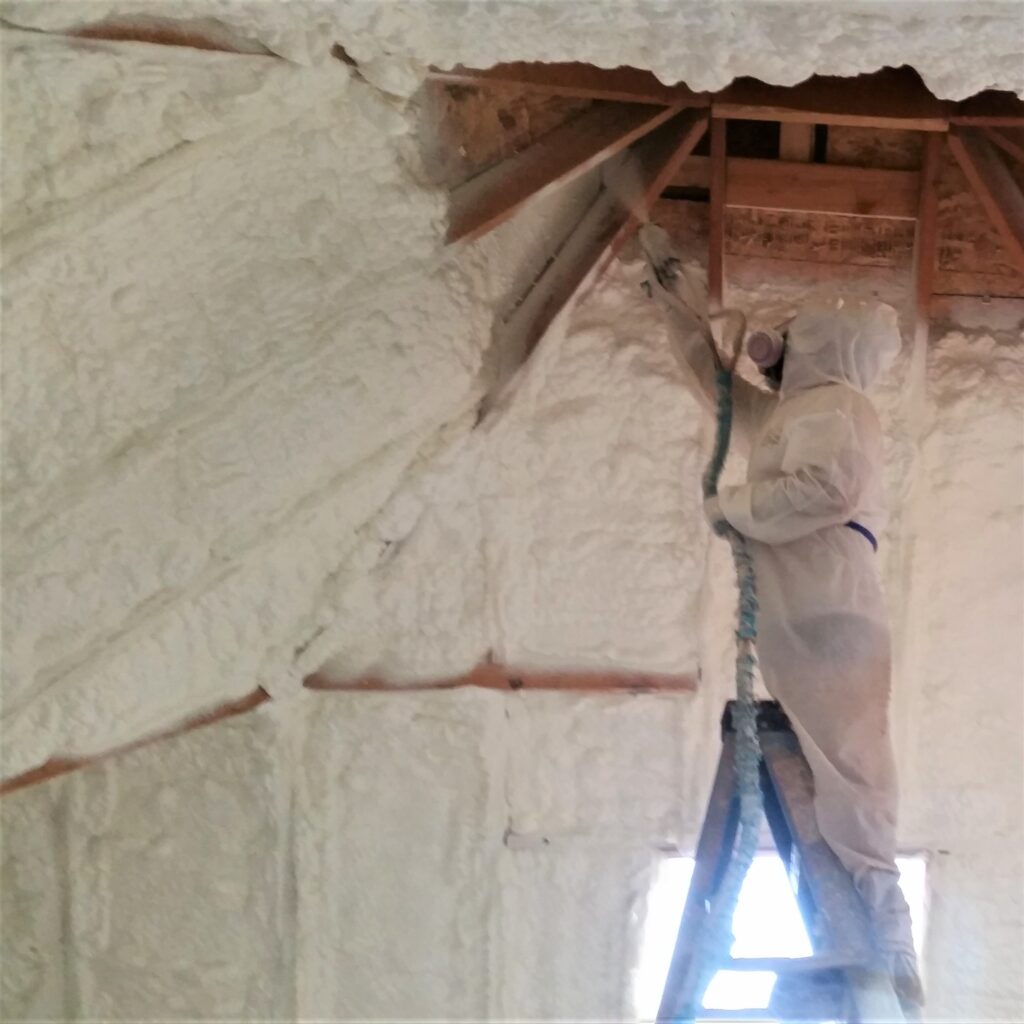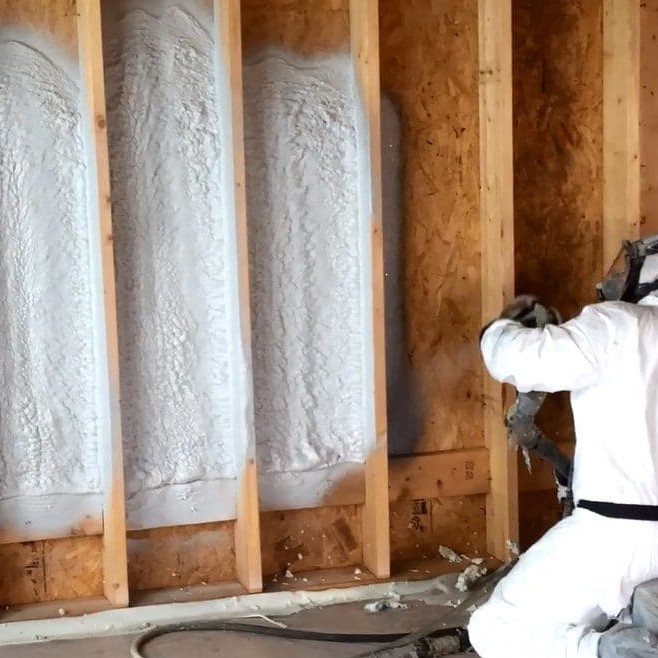Home And Attic Spray Foam Insulation Services
Dallas Professional Spray Foam Insulation ContractorHome And Attic Spray Foam Insulation Services
Dallas Professional Spray Foam Insulation ContractorSpray polyurethane foam (SPF) represents a versatile sprayed-on plastic material renowned for its insulation capabilities and its role as an effective air and/or moisture barrier across a range of areas including roofs, attics, crawl spaces, walls, and basements. Comprising two fundamental components – ‘A’ isocyanate and ‘B’ resin – SPF undergoes a chemical reaction upon expert mixing, resulting in the creation of foam. This foam, expelled through specialized equipment under elevated temperatures in liquid form, expands upon contact with surfaces, adeptly filling cracks, gaps, and voids.
The two distinct variations of spray foam insulation are open-cell and closed-cell foam. Open-cell foam, with its low density and sponge-like texture, expands significantly upon application, making it a favorable choice for interiors where it serves insulation, air sealing, and noise reduction purposes. On the other hand, closed-cell foam boasts medium to high density, with a rigid structure that is impermeable to air and water. This characteristic renders it suitable for both indoor and outdoor applications in construction. Optimal foam selection hinges on the application’s specifics and extends beyond the consideration of just R-values. Both open-cell and closed-cell spray foam insulation can be effectively deployed within walls, ceilings, floors, crawl spaces, and attics, offering heightened energy efficiency and diminished heating and cooling expenses for both newly constructed and existing homes.
Why Upgrade Your Insulation To Spray Foam?
- Make your home more energy efficient compared to using traditional insulation methods
- Could reduce energy cost of a home up to 50 percent.
- Improve your comfort no matter the season
- Minimize the amount of air that escapes from the inside to the outside or vice versa
- Reduce the amount of outside noise that enters the inside space
- Increase HVAC equipment life
- Stabilize indoor temperatures for a comfortable environment
Open Cell Spray Foam Insulation
Open Cell Spray Foam Insulation

Open-cell foam stands out as a low-density, non-structural insulation solution prized for its remarkable efficiency, exceptional air isolation capabilities, and versatile R-values. Its impressive acoustical performance often comes with a more budget-friendly price point than closed-cell foam of equivalent thickness, although it does offer slightly lower R-values per inch. While not universally ideal, open-cell foam frequently emerges as the superior choice for numerous residential applications across the Dallas-Fort Worth region.
The unique open-cell structure of this foam variety makes it particularly well-suited for deployment in hot and humid climates, and beneath roof sheathing, such as within conditioned attics. With just a 1-inch thickness, open-cell foam delivers an R-value of 3.8. As thickness increases to 3.5 inches, the R-value reaches R-13, and at 5.5 inches, it achieves an R-19 rating. What sets spray foam apart is its dual functionality: not only does it provide insulation, but it also excels at air sealing. This distinctive attribute distinguishes it from conventional blown or batted insulation methods. It’s worth noting that direct comparisons of R-values between different insulation types may not yield accurate results due to these unique characteristics.
Open-cell spray foam insulation presents an innovative solution that combines affordability, energy efficiency, and acoustic performance. Its unique properties make it an excellent choice for various applications, delivering unparalleled comfort and cost savings. Discover how open-cell spray foam can transform your building’s insulation strategy. Reach out to us today to explore the benefits and possibilities of this cutting-edge insulation solution.
Benefits of Open-Cell Spray Foam Insulation:
- Excellent Acoustic Performance: Open-cell spray foam effectively absorbs sound waves, making it an exceptional choice for noise reduction within buildings.
- Enhanced Air Isolation: This insulation’s open-cell structure contributes to improved air isolation, helping maintain consistent indoor temperatures and reducing energy waste.
- Affordability: Open-cell spray foam insulation is often more budget-friendly compared to closed-cell alternatives, making it an attractive choice for cost-conscious projects.
- Flexibility and Expansion: Upon application, open-cell foam expands significantly, filling gaps and voids to create a seamless, continuous insulation layer.
- Moisture Management: While permitting air permeability, open-cell spray foam also manages moisture effectively, preventing condensation and reducing the risk of mold growth.
Applications of Open-Cell Spray Foam:
- Interior Insulation: Open-cell spray foam is ideal for interior applications where sound insulation and air sealing are key, such as walls and floors.
- Crawl Spaces and Attics: Its capacity to manage moisture makes open-cell spray foam a suitable choice for crawl spaces and attics, enhancing energy efficiency and preventing mold growth.
- Climate Adaptability: Open-cell spray foam is particularly effective in hot and humid climates due to its breathable structure that allows for moisture management.
- Noise Reduction: It is commonly employed in areas where noise reduction is essential, such as commercial spaces, residential walls, and ceilings.
Closed Cell Spray Foam Insulation
Closed Cell Spray Foam Insulation

Closed-cell spray foam insulation is a cutting-edge solution designed to transform the way we approach energy efficiency and building comfort. Crafted from polyurethane foam, this advanced insulation material is renowned for its remarkable attributes that elevate both insulation performance and structural integrity It is called “closed-cell” because the cells in the foam are closed, or not open to the air. This gives the foam a higher density and a stronger, more rigid structure.
One of the main advantages of closed-cell spray foam is its high R-value. The R-value is a measure of insulation’s ability to resist heat flow. The higher the R-value, the more effective the insulation. Closed-cell spray foam has an R-value of around 6.0 per inch, making it one of the most efficient insulation materials available. In addition to its high R-value, closed-cell spray foam also provides a vapor and air barrier. This means it can help prevent moisture from entering a building and can also help reduce air leakage, which can lead to energy savings.
While closed-cell spray foam insulation may carry a higher upfront cost compared to some alternatives, its unparalleled performance, durability, and energy-saving potential make it a smart long-term investment for any structure. Discover the transformative benefits of closed-cell spray foam insulation and elevate your building’s comfort, efficiency, and sustainability. Contact us today to explore how closed-cell spray foam can revolutionize your insulation strategy.
Benefits of Closed-Cell Spray Foam Insulation:
- High R-Value: Closed-cell spray foam insulation boasts an impressive R-value of approximately 6.0 per inch. This means it effectively resists heat flow, enhancing thermal insulation and reducing energy consumption.
- Air and Vapor Barrier: This insulation acts as a dual barrier against air and vapor infiltration. It significantly reduces air leakage, moisture intrusion, and subsequent issues such as mold growth and structural deterioration.
- Structural Reinforcement: Closed-cell spray foam expands and adheres robustly to surfaces, fortifying the structural integrity of buildings. It effectively seals gaps, cracks, and voids, contributing to a more solid and resilient structure.
- Water and Pest Resistance: Thanks to its impermeability, closed-cell spray foam is resistant to water and pests, making it a durable and long-lasting choice for insulation.
- Versatile Applications: This insulation is highly adaptable, suitable for both interior and exterior applications. It is used in roofs, walls, attics, crawl spaces, and more, making it a versatile solution for various building structures.
Applications of Closed-Cell Spray Foam:
- Roofing and Attics: Closed-cell spray foam creates an effective barrier against heat transfer, keeping attics cooler in summer and warmer in winter.
- Wall Insulation: Its robust structure reinforces walls and prevents thermal bridging, ensuring even temperature distribution and enhanced comfort.
- Crawl Spaces and Basements: By sealing off crawl spaces and basements, closed-cell spray foam minimizes moisture infiltration and helps prevent mold growth.
- Commercial and Residential Structures: This insulation is equally beneficial for both commercial and residential buildings, contributing to energy efficiency and occupant comfort.
Is Your Home Ready For spray foam Insulation?
There are a few things that you should check first!Is Your Home Ready For spray foam Insulation?
There are a few things that you should check first!Or Before installing new insulation in your home there are a few things that you should check and some decisions you should make before moving forward with your insulation project.
Has Your Old Insulation Been Removed?
Removing old insulation before adding spray foam insulation is a crucial step that ensures optimal performance and long-term benefits. Old insulation, especially if damaged, damp, or deteriorated, can hinder the effectiveness of the new spray foam layer. It may create air pockets, prevent proper adhesion, and compromise the insulation’s overall sealing properties. Additionally, removing old insulation provides the opportunity to thoroughly inspect the underlying structure for potential issues like mold growth, pest infestations, and structural damage. By starting with a clean slate, the new spray foam insulation can be applied directly to a sound and stable surface, maximizing its air-sealing capabilities and enhancing energy efficiency. Ultimately, the removal of old insulation sets the foundation for a seamless and effective insulation upgrade, ensuring that your building benefits fully from the advantages of modern spray foam insulation.
Do You Have A Gas Furnace Or Water Heater In A Conditioned Attic?
Gas furnaces and water heaters located in a spray foamed attic require dedicated fresh air ventilation to ensure safe and efficient operation. Spray foam insulation creates a highly sealed and airtight environment, which can potentially lead to restricted air exchange. Gas appliances rely on a steady supply of fresh air for combustion and proper functioning. Without adequate ventilation, there’s a risk of incomplete combustion, accumulation of harmful gases like carbon monoxide, and reduced furnace or water heater efficiency. To address this, a well-designed ventilation system is essential, providing a controlled flow of outdoor air to the gas appliance while maintaining the attic’s insulation performance. This strategic approach safeguards both the furnace’s operation and indoor air quality, ensuring a safe and comfortable living environment while reaping the benefits of a spray foamed attic.
Are You Bathroom And Laundry Vents Exhausting To The Outside?
Running indoor ventilation fans to the outside before spray foaming your attic is a crucial precaution to ensure safety and the effectiveness of the insulation process. Spray foam insulation creates an airtight seal that significantly reduces air exchange between indoor and outdoor environments. If ventilation fans, such as bathroom exhaust fans, are left connected to the interior without proper ducting to the exterior, they can inadvertently introduce moist or humid air into the attic space. This moisture can accumulate within the sealed attic, potentially leading to mold growth, wood deterioration, and compromised insulation performance. By rerouting these ventilation fans to exhaust directly to the outside, you prevent excess moisture from infiltrating the attic, preserving the integrity of the insulation and preventing potential moisture-related issues. This precautionary step ensures that the attic remains a controlled and moisture-free environment, maximizing the benefits of the spray foam insulation and maintaining the overall health of your home’s structure.
Should My HVAC Ductwork In The Attic Be Sealed If I am Creating A Conditioned Attic Space With Spray Foam?
In a conditioned spray foam attic space, the significance of duct leaks can vary based on the specific circumstances. Generally, duct leaks matter less in such an environment compared to traditional attics due to the airtight seal created by the spray foam insulation. The insulation effectively eliminates the temperature differential between the attic and conditioned living areas, reducing the impact of duct leakage on energy efficiency. However, while duct leaks might have a diminished effect on conditioned spaces, addressing them remains important to maintain the overall efficiency of your HVAC system. Leaks can still result in air and energy losses, uneven cooling or heating, and potential negative impacts on indoor air quality. Therefore, while duct leaks may not have as pronounced an impact in a conditioned spray foam attic, it’s recommended to address them to ensure optimal HVAC performance and to minimize any potential issues associated with air quality and temperature control.
Do I Need Soffit Vents OR Exhaust Vents If I Am Creating A Conditioned Attic Space With Spray Foam?
In a conditioned attic space, the traditional need for soffit vents or exhaust vents is eliminated due to the unique characteristics of the environment created by spray foam insulation. Soffit vents, which typically allow for air intake, and exhaust vents, which facilitate air circulation and heat dissipation, are commonly employed in unconditioned attics to regulate temperature and prevent moisture buildup. However, in a conditioned attic space insulated with spray foam, the insulation forms an effective air and moisture barrier. This barrier, combined with the sealing effect of the spray foam, minimizes the impact of outside air, temperature fluctuations, and humidity on the attic environment. As a result, the necessity for soffit and exhaust vents is discarded. Instead, the focus shifts towards maintaining a controlled and sealed environment, ensuring optimal energy efficiency and consistent temperature throughout the conditioned living spaces. While the specific requirements may vary based on building design and climate, the airtight properties of spray foam insulation contribute to minimizing the conventional need for attic ventilation components in a conditioned space.
Is There Any Preparation Before Spraying Foam In My Home?
Preparing your existing home before installing spray foam insulation is a fundamental step that paves the way for a successful and effective insulation upgrade. Proper preparation ensures that the insulation process is seamless, maximizes the insulation’s benefits, and minimizes potential complications. First, clearing the area of clutter, obstructions, and debris provides an unobstructed workspace for the installation team. Covering or protecting items susceptible to overspray safeguards them from potential damage. Inspecting the building’s structural integrity before install allows for addressing any underlying issues that could impact the insulation’s performance, such as moisture infiltration, mold growth, or pest infestations. Proper ventilation and safety measures are essential for the well-being of both occupants and installation professionals. Ultimately, thorough preparation sets the stage for a smooth insulation process, ensuring optimal adhesion, sealing, and insulation coverage, which in turn translates to enhanced energy efficiency, comfort, and long-term benefits for your home.
The Difference Between R-Value Of Blown Or Batted Insulation And Spray Foam
When transitioning from blown insulation to spray foam insulation, the concept of R-value should be understood in a different light. The R-value measures the ability of insulation to resist heat transfer, and while blown insulation and spray foam insulation share this common metric, they diverge in their mechanisms and efficiency. Spray foam insulation, with its superior air-sealing properties and capacity to fill gaps and voids, functions as both an insulator and an air barrier. As such, it curbs air leakage that conventional blown insulation might struggle to address. This distinct functionality means that achieving the same R-value with spray foam insulation is not a direct comparison. Spray foam’s ability to control air infiltration inherently boosts energy efficiency and reduces heat loss, thus allowing for a reduced R-value compared to conventional blown insulation. While the numerical R-values might differ, the comprehensive benefits of spray foam insulation in terms of sealing, insulation, and overall energy performance make it a valuable alternative, even with a lower apparent R-value.
Should I Air Seal My Attic Floor Before Having Foam Installed To Create A Conditioned Attic Space?
No! If you’re planning to create a conditioned attic space with spray foam insulation, it’s important to reconsider the traditional approach of air sealing the attic floor. Unlike conventional insulation methods, spray foam creates an airtight seal on its own, eliminating the need for additional air sealing measures at the attic floor level. In fact, attempting to air seal the attic floor in a conditioned space insulated with spray foam can hinder the intended ventilation and temperature control mechanisms. The spray foam itself acts as a comprehensive air and moisture barrier, efficiently preventing the movement of air between the conditioned living spaces and the attic. By allowing this barrier to function naturally, you maintain the intended separation between the conditioned space and the unconditioned attic. Attempting to further air seal the attic floor could disrupt this balance and potentially compromise the overall performance and efficiency of the conditioned attic space.
Looking for insulation removal information or blown attic insulation alternatives?
Want More Information About Insulation Removal?
Insulation removal can be a challenging task, but it is sometimes necessary in order to improve the comfort, efficiency, and overall indoor living conditions of your home. An attic filled with old, dusty, and potentially contaminated insulation may pose a health risk to the occupants of the home and also hinder energy efficiency. If you need to remove old attic insulation in the Dallas area, Perkins Inc. is a specialized company that can handle the job safely and effectively. Don’t let old, dirty insulation impact your health and comfort – consider insulation removal as a solution.
Learn More About Spray Foam Insulation for Conditioned Attics
A spray foam conditioned attic space is an insulation system that uses a special insulation material to seal and insulate the attic of a building. The foam is applied as a liquid and expands to fill the space between the rafters on the underside of the roof deck down to the exterior top plates. This creates a continuous, airtight seal. This air seal helps to regulate the temperature in the attic, keeping it within 2 to 10 degrees of the temperature inside the home, making it more comfortable and energy efficient. Spray foam insulation is a widely used option for attics due to its ability to effectively seal and insulate the space.
Contact Perkins Inc.
Perkins Inc.
Energy Conservation
Office :
469 831 1119
Location :
Frisco Texas
Service Area:
Allen, Arlington, Bedford, Carrollton, Dallas, Euless, Flower Mound, Fort Worth, Frisco, Garland, Grand Prairie, Grapevine, Heath, Hurst, Irving, Lewisville, McKinney, Mesquite, Plano, Richardson, Rockwall, Rowlett, and Surrounding Areas
Contact Perkins Inc.
Perkins Inc.
Energy Conservation
Office :
469 831 1119
Location :
Frisco Texas
Service Area:
Allen, Arlington, Bedford, Carrollton, Dallas, Euless, Flower Mound, Fort Worth, Frisco, Garland, Grand Prairie, Grapevine, Heath, Hurst, Irving, Lewisville, McKinney, Mesquite, Plano, Richardson, Rockwall, Rowlett, and Surrounding Areas


